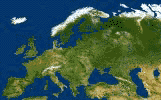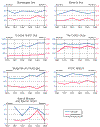 |
 |
 |
||||||||
EUROPE’S ENVIRONMENT : THE SECOND ASSESSMENT An overview
You are on the pages "Inland waters" and "Marine and coastal environment"
European Environment Agency,

There has been a general reduction in total water abstraction in many countries since 1980. In most countries, industrial abstraction has been falling slowly since 1980 because of the shift away from industries that are heavy users of water, the growth of services, technical improvements and increased recycling. However, demand around urban areas may still exceed availability and, in the near future, water shortages may occur. Future water supply may also be affected by climate change. Agriculture is the most important user of water in Mediterranean countries, mainly for irrigation. The area under irrigation and the abstraction of water for irrigation have been rising steadily since 1980. In southern European countries, 60% of all water abstracted is used for irrigation. In some regions, groundwater abstraction is exceeding the recharge rate, causing lowering of the groundwater table, loss of wetlands and seawater intrusion. Tools for limiting future demand for water include improvements in the efficiency of water use, price controls and agricultural policy. Despite the introduction of water quality targets in the EU and the attention to water quality in the Environmental Action Programme for Central and Eastern Europe, there has been no overall improvement of river quality since 1989/90. European countries report different trends without any consistent geographical pattern. There have been some improvements in the most seriously polluted rivers, however, since the 1970s. Phosphorus and nitrogen continue to cause eutrophication of surface waters. Improvements in waste-water treatment and reductions in emissions from large industries between 1980 and 1995 resulted in total discharges of phosphorus into rivers falling by between 40% and 60% in several countries. Phosphorus concentrations in surface waters decreased significantly, particularly in those previously most severely affected. Further improvements are expected since the recovery time, particularly of lakes, may be several years. Phosphorous concentrations at about a quarter of the river monitoring sites are still about ten times higher than those in water of good quality. Nitrogen, of which the main source is agriculture, is less of a problem in rivers, but can cause problems when transported to the sea; emissions need to be further controlled to protect the marine environment. Groundwater quality is affected by increasing concentrations of nitrate and pesticides from agriculture. Nitrate concentrations are low in northern Europe, but high in several Western and Eastern countries, with frequent exceedances of the EU maximum admissible concentration. The application of pesticides in the EU fell between 1985 and 1995, but this does not necessarily indicate a decrease in environmental impact since the range of pesticides in use has changed. Groundwater concentrations of certain pesticides frequently exceed EU maximum admissible concentrations. Significant pollution from heavy metals, hydrocarbons and chlorinated hydrocarbons has also been reported from many countries. Integrated polices for the protection of inland waters are in place in many areas of Europe, for example around the North Sea, the Baltic Sea, the Rhine, the Elbe and the Danube. Although much has been achieved, better integration of environmental policies with economic policies remains a challenge for the future. Agricultural policy, in particular, will be the key for tackling inputs from diffuse sources, but this continues to be both technically and politically difficult. Although reform under the Common Agricultural Policy of the European Union is being used to integrate measures to reduce nutrient inputs, more will have to be done – for example, to ensure that policies such as setting aside agricultural land are designed to maximise environmental benefits. The EU Urban Waste Water Treatment and Nitrate Directives should deliver substantial quality improvements, but their success depends on the extent to which Member States designate sensitive areas and vulnerable zones. The proposal for a Water Framework Directive will require integrated programmes of management and improvement. If implemented in a comparable way across the EU, this Directive, coupled with a further switch to demand-side management, should lead to marked improvements in water quality and to the sustainable management of water resources. Freshwater availability in Europe Source: Eurostat, OECD, Institute of Hydrology
(Click on the image to enlarge)
The most threatened seas are the North Sea (over-fishing, high nutrient and pollutant concentrations), the Iberian seas (i.e. the part of the Atlantic along the eastern Atlantic shelf, including the Bay of Biscay: over-fishing, heavy metals), the Mediterranean sea (locally high nutrient concentrations, high pressure on the coasts, over-fishing), the Black Sea (over-fishing, rapid increase of nutrient concentrations) and the Baltic Sea (high nutrient concentrations, pollutants, over-fishing). Eutrophication, mainly resulting from nutrient surpluses in agriculture, is of major concern in some parts of many European seas. Nutrient concentrations are generally at the same level as in the beginning of the 1990s. Increases in nitrogen discharges and resulting concentrations in sea water on some of the west coasts of Europe seem to be correlated with high precipitation and flooding between 1994 and 1996. In most other seas, no clear trend in nutrient concentrations could be identified. However, concentrations of nutrients in the Black Sea, mainly originating from the Danube watershed, increased about tenfold between 1960 and 1992. Contamination of sediments and biota by anthropogenic chemicals seems to be common in almost all European seas. Only limited data was available, mainly covering western and north-western Europe. Elevated concentrations (above natural background) of heavy metals and PCBs have been found in fish and sediment, with high levels near point sources of emission. Bio-accumulation of these substances may pose a threat to ecosystems and human health (as discussed in the chapter on chemicals). The overall picture of oil pollution is highly fragmentary, and no reliable assessment of general trends can be made. The main source is from land, reaching the seas through rivers. Although the annual number of oil spills is falling, small and occasional large spills in zones of heavy boat traffic are causing significant local damage, primarily smothering of beaches and seabirds and impairment of harvest of fish and shellfish. There is, however, no evidence of irrevocable damage to marine ecosystems, either from major spills or from chronic sources of oil. Many seas continue to be heavily over-fished, with particularly serious problems in the North Sea, the Iberian seas, the Mediterranean and the Black Sea. There is a critical over-capacity in the fishing fleet, and a reduction of 40% in capacity would be needed to match available fish resources. Nitrogen and phosphorus discharges Source: EEA - ETC/MC |
|||||||||


